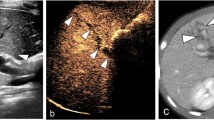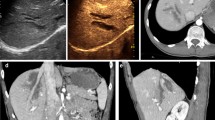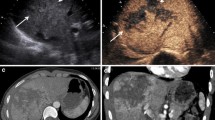Abstract
Background
There is no controversy about the use of CT for detection of internal injuries in patients with high-energy multitrauma. However, in most patients isolated blunt abdominal trauma is mild or moderate and the risk of injury to organs other than the liver, spleen or kidneys is minimal. CT scanning exposes patients to radiation, and may often be avoided if significant damage to these three organs can be visualized by contrast-enhanced ultrasonography (CEUS).
Materials and Methods
In our series SonoVue (Bracco, Milan) and Siemens Acuson Sequoia ultrasound machines were used. Initially patients with injuries detected by CT were examined using CEUS. Subsequently CEUS was used as the first and only modality in patients with mild or moderate blunt abdominal trauma to one flank, provided that they were able to cooperate and were otherwise suitable for US examination.
Results
CEUS was able to sensitively detect lacerations and haematomas in the liver, spleen and kidneys in cooperative patients. CEUS also demonstrated very thin lacerations of the parenchyma of these organs. These results were also found in children.
Conclusion
In our experience CEUS is an accurate and valuable tool for the detection or exclusion of parenchymal damage to the liver, spleen and kidneys. With the proper organization, standardized dynamic documentation and well-trained sonographers, CEUS may replace CT in many patients with mild to moderate blunt abdominal trauma, thus avoiding unnecessary exposure to radiation in this often young and healthy population.
Similar content being viewed by others
References
Stuhlfaut JW, Anderson SW, Soto JA (2007) Blunt abdominal trauma: current imaging techniques and CT findings in patients with solid organ, bowel and mesenteric injury. Semin Ultrasound CT MR 28(2):115–129
Shuman WP (1997) CT of blunt abdominal trauma in adults. Radiology 205(82):297–306
Yoshii H, Sato M, Yamamoto S et al (1998) Usefulness and limitations of ultrasonography in the initial evaluation of blunt abdominal trauma. J Trauma 45(1):45–50
Brown MA, Sirlin CB, Hoyt DB, Casola G (2003) Screening ultrasound in blunt abdominal trauma. J Intensive Care Med 18(5):253–260
McGahan JP, Richards J, Fogata ML (2004) Emergency ultrasound in trauma patients. Radiol Clin North Am 42(2):417–425
Stengel D, Bauwens K, Porzsolt F et al (2003) Emergency ultrasound for blunt abdominal trauma-meta-analysis update 2003. Zentralbl Chir 128(12):1027–1037
Valentino M, Serra C, Zironi G et al (2006) Blunt abdominal trauma: emergency contrast-enhanced sonography for detection of solid organ injuries. AJR Am J Roentgenol 186(5):1361–1367
McGahan JP, Horton S, Gerescovich EO et al (2006) Appearance of solid organ injury with contrast-enhanced sonography in blunt abdominal trauma: preliminary experience. AJR Am J Roentgenol 187(3):658–666
Sparano A, Acampora C, di Nuzzo L et al (2006) Color power Doppler US and contrast-enhanced US features of abdominal solid organ injuries. Emerg Radiol 12(5):216–222
Catalano O, Lobianco R, Raso MM, Siani A (2005) Blunt hepatic trauma: evaluation with contrast enhanced sonography: sonographic findings and clinical application. J Ultrasound Med 24(3):299–310
Catalano O, Lobianco R, Sandomenico F et al (2004). Real time contrastenhanced imaging in emergency radiology. Radiol Med (Torino) 108(5–6):454–469
Miele V, Buffa V, Stasolla A et al (2004) Contrast enhanced ultrasound with second generation contrast agent in traumatic liver lesions. Radiol Med (Torino) 108(1–2):82–91
Oldenburg A, Hohmann J, Skrok J, Albrecht T (2004) Imaging of paediatric splenic injury with contrastenhanced ultrasonography. Pediatr Radiol 34(4):351–354
Yegiyants S, Abou-Lahoud G, Taylor E (2006) The management of blunt abdominal trauma patients with computed tomography scan findings of free peritoneal fluid and no evidence of solid organ injury. Am Surg 72(10):943–946
Brenchley J, Walker A, Sloan JP et al (2006) Evaluation of focussed assessment with sonography in trauma (FAST) by UK emergency physicians. Emerg Med J 23(6):446–448
Author information
Authors and Affiliations
Corresponding author
Rights and permissions
About this article
Cite this article
Thorelius, L. Emergency real-time contrast-enhanced ultrasonography for detection of solid organ injuries. Eur Radiol Suppl 17 (Suppl 6), 107–111 (2007). https://doi.org/10.1007/s10406-007-0235-4
Published:
Issue Date:
DOI: https://doi.org/10.1007/s10406-007-0235-4




